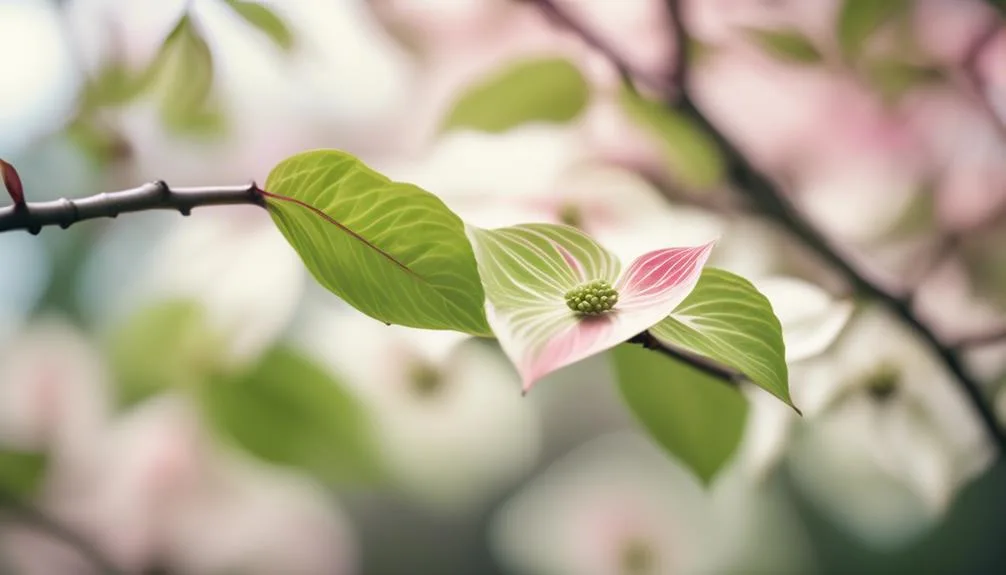Dogwood trees are known for their striking green and white variegated leaves. But have you ever wondered why they have this unique feature? The answer involves a combination of genetics, environment, and evolution. Understanding the factors behind the variegated leaves offers insights into the tree's survival mechanisms.
Exploring the world of dogwood trees and their variegated leaves reveals the fascinating processes that contribute to this natural wonder.
Genetics of Variegated Leaves in Dogwood Trees
Understanding the genetics behind variegated leaves in dogwood trees provides valuable insights into the fascinating interplay of genes that result in their unique and captivating patterns.
Leaf variegation, the occurrence of differently colored areas on the same leaf, is a result of genetic inheritance. This phenomenon is caused by a mutation in the chlorophyll-producing genes. The variegated patterns are often a result of the differential expression of these mutated genes in different parts of the leaf. While some areas may have normal chlorophyll production, others may have reduced or absent chlorophyll, leading to the unique color patterns.
The inheritance of variegation in dogwood trees can follow various patterns, including maternal inheritance, cytoplasmic inheritance, or nuclear inheritance. Understanding these genetic mechanisms sheds light on the intricate processes that give rise to the stunning variegated leaves in dogwood trees.
Environmental Factors Impacting Dogwood Leaf Color
Environmental factors play a significant role in determining the vibrant hues and patterns of dogwood leaves, influencing their overall coloration and visual appeal. The impact of pollution and climate change on dogwood leaf color can be profound, causing shifts in pigmentation and leaf patterns.
Seasonal changes also play a crucial role, with factors like temperature and light affecting the intensity of colors. In addition, soil nutrients can greatly affect variegated leaves, with deficiencies or imbalances leading to altered leaf pigmentation.
These factors create a dynamic interplay that influences the striking array of colors and patterns seen in dogwood leaves, making them not only a beautiful sight but also a reflection of the intricate relationship between the environment and plant life.
Role of Pigments in Creating Variegated Dogwood Leaves
Amidst the intricate interplay of environmental factors impacting dogwood leaf color, the role of pigments in creating variegated dogwood leaves emerges as a fascinating and pivotal aspect of their vibrant display.
Pigment distribution within the leaves plays a crucial role in the mesmerizing leaf patterning observed in variegated dogwood trees. The distribution of pigments, particularly chlorophyll, carotenoids, and anthocyanins, varies within the leaf tissues, leading to the distinct patterns of green, white, and pink.
Chlorophyll, responsible for the green color, is essential for photosynthesis, while carotenoids contribute to yellow and orange hues. Anthocyanins, which develop in response to environmental stresses, provide the striking red and pink colors.
The varying concentrations and distribution of these pigments across the leaf surface create the beautiful and unique variegated patterns that make dogwood trees a stunning addition to any landscape.
Evolutionary Advantage of Variegated Leaves in Dogwood Trees
With their variegated leaves, dogwood trees have evolved to provide a distinct advantage in their survival and reproduction within their natural habitats. This evolutionary adaptation has conferred several ecological benefits, ensuring the continued success of dogwood trees:
- Enhanced Photosynthesis: Variegated leaves contain areas of different pigmentation, which allows for optimized light absorption and increased photosynthetic efficiency.
- Temperature Regulation: The variation in leaf coloration helps regulate leaf temperature, preventing excessive water loss and maintaining optimal conditions for metabolic processes.
- Defense Mechanism: Variegation can act as a form of camouflage, making it harder for herbivores to identify and consume the leaves, thus increasing the tree's chances of survival and reproduction.
Human Influence on Dogwood Leaf Variegation
In the realm of horticulture and selective breeding, human intervention has played a pivotal role in influencing the variegation of dogwood tree leaves, shaping their visual appeal and adaptability to diverse environmental conditions.
Through selective breeding, horticulturists have been able to identify and propagate specific genetic mutations that result in variegated leaves. By carefully selecting and breeding trees with desirable variegation patterns, humans have been able to influence and enhance the natural variegation found in dogwood trees.
This process has allowed for the development of dogwood varieties with unique and striking leaf patterns, contributing to the aesthetic diversity of these trees in landscapes and gardens.
Through human intervention and selective breeding, the variegation of dogwood leaves has been intentionally manipulated to create visually captivating and environmentally adaptable tree varieties.
Conclusion
Intriguingly, the variegated leaves of dogwood trees are a product of genetics, environmental influences, pigments, and human impact.
This unique leaf coloration not only enhances the tree's beauty but also offers an evolutionary advantage.
Consider the intricate interplay of these factors in creating the mesmerizing phenomenon of variegated dogwood leaves.

My interest in trees started when I first saw the giant sequoias in Yosemite.
I was a teenager then, and I remember thinking, “I need to learn more about this.”
That moment stuck with me.
A few years later, I went on to study forestry at Michigan Tech.
Since graduating, I’ve worked in a mix of hands-on tree care and community education.
I’ve spent over ten years helping people understand how to plant, maintain, and protect the trees in their neighborhoods.
I don’t see trees as just part of the landscape.
They are living things that make a real difference in our daily lives.
